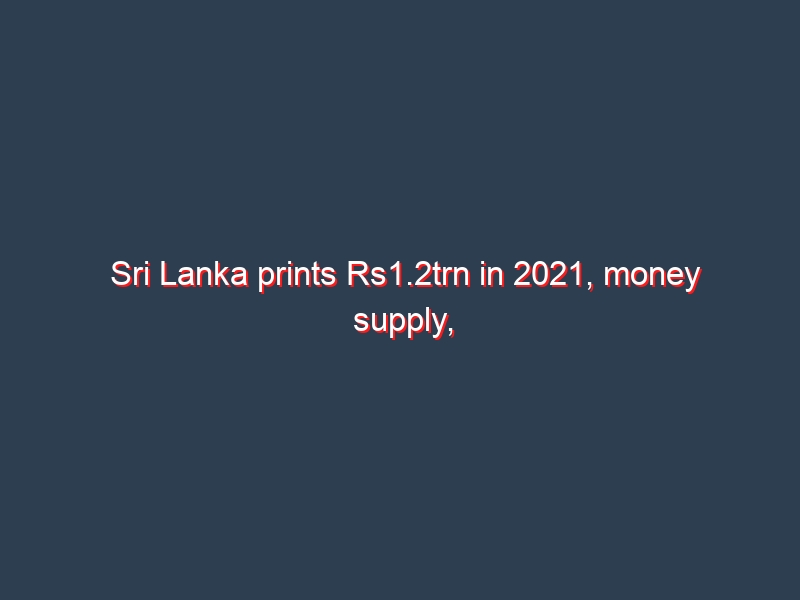ECONOMYNEXT – Sri Lanka has printed 1.2 trillion rupees in 2021 most of which has flowed out of the country as a balance of payments deficit official data shows on top of 505 billion rupees printed in 2019 mostly to keep interest rates down.
Central bank credit to government grew to 2,093 billion rupees by December 2021 from 868.9 billion rupees a year earlier.
A part of the central bank credit to government including over 200 billion in July 2021 relates to foreign reserves appropriated to repay bonds, which did not create domestic inflation. However they prevented the monetary system from tightening and rates from rising.
In 2020 Sri Lanka printed 505.9 billion rupees based on official data, but the liquidity injected to the banking system was much higher. Money was injected also by a cut in the statutory reserve ratio. In a bizarre move the money was re-printed in September 2021.
BOP hit
In 2020 some of the money was printed to give Covid-19 re-finance.
In the way data is currently calculated in Sri Lanka, printed money remaining as excess liquidity in the system does not get captured as central bank credit until it disappears from the country as a BOP deficit. At the beginning of December 200 billion rupees of excess liquidity remained in the system.
A large part of the money in both years was printed came from yield controls imposed on Treasuries auctions, which caused them to fail and liquidity to be injected.
After August 2021 price controls were lifted and bond auctions were mostly successful.
However since then money is printed mostly to sterilize reserves given for imports. The central bank is also printing money for remittances.
The money boomerangs as import demand when the families of expat workers spend them and more reserves are lost as they new money is exchange for dollars via imports.
In 2021 Sri Lanka was hit by a balance of payments deficit of 2.3 billion rupees as the printed money was exchanged for monetary reserves.
In 2021, the BOP deficit was 3.9 billion US dollars.
Related
Sri Lanka BOP deficit hits record US$3.9bn in 2021 amid money printing
In September 2021, a statutory reserve ratio was hiked and the entire money was printed in a bizarre move.
Inflation
In the two years reserve money has grown 40 percent. Broad money had also grown 40 percent despite weak economic growth, creating conditions for rapid price rises.
While liquidity injections hit the balance of payments fast (4 to 6 weeks) with imported goods coming in to fill domestic demand.
Persistent money printing to keep rates down leads to growth in credit and broad money, triggering domestic inflation.
When rates are kept down artificially, money also go to long term assets, driving up a speculative bubble. People may also buy assets fearing inflation or currency depreciation. Capital flight may also take place.
In most countries broad money growth turns in to domestic inflation after 12 to 24 months. Similar problems had been seen in countries like the US.
In Sri Lanka the broader consumer price index, which also includes services which rises slowly, has risen 17 percent over the two years.
Food prices have risen 40 percent.
Sri Lanka exported and imported goods also rise when the US prints money, driving up commodity prices. Traded goods respond quicker to loose policy.
Related
US inflation likely to stay high in 2022, 2023 even if Fed tightens now: Steve Hanke
Anchor Conflicts
Sri Lanka’s monetary policy deteriorated rapidly after the end of a 30-year war and accelerated after the retirement of Deputy Governor W A Wijewardena, analysts have said.
Sri Lanka stated following ‘flexible’ inflation targeting, a highly discretionary domestic anchor, despite having a foreign reserve collecting highly unstable peg with the US dollar called a ‘flexible’ exchange rate as an external anchor, which are in conflict with each other.
Though Sri Lanka had a Latin America style central bank from 1950 set up by a US money doctor, the island’s commercial borrowings were limited.
After 2015, monetary instability ratcheted as anchor conflicts worsened leading to a rapid rise in commercial debt.
When money is printed (inflationary policy is followed with a peg) foreign reserves cannot be built with current inflows and also the ability to repay maturing debt and interest with current inflows is lost.
In 2015, 2016 and 2018 the country could not repay maturing debt with current inflows as inflationary policy (money printing) was followed under ‘flexible’ inflation targeting coupled with liquidity injected to target call money rate.
Under ‘flexible’ inflation targeting with-reserve-collecting-peg, liquidity injections start about two years after monetary tightening ends a currency crisis claiming that inflation is low (Sept 2014, March 2018 and Feb 2020) which is roughly the time it takes for inflation from the previous money printing bout to dissipate, triggering another crisis.
In 2020 and 2021, though sovereign bonds were repaid, the central bank’s reserves were run down and it has become a large net debtor as fiscal debt was effectively transferred to the monetary authority. (Colombo/Feb14/2022)

